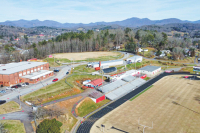HCC hosts conservation heritage event
Haywood Community College, in partnership with the North Carolina Wildlife Resources Commission are hosting an event on the campus of Haywood Community College to celebrate our national conservation heritage.
Celebrate National Hunting and Fishing Day
The N.C. Wildlife Resources Commission will host two family-friendly events to recognize National Hunting and Fishing Day, an annual celebration promoting outdoor recreation and conservation.
HCC hosts Dahlia Ridge Trail Run
Haywood Community College will hold the second annual Dahlia Ridge Trail Run on Saturday, Sept. 14. This 5K is a timed, family-friendly walk/run event open to all levels of runners, walkers and hikers.
Notes from a plant nerd: Playing with a full deck
Dear reader, yeah, I mean you. You who are reading this while holding the paper in your hands or scanning through on your computer, tablet or phone. Yeah, you. I am so deeply grateful to you for reading my articles. This marks the 52nd column that I have written for The Smoky Mountain News, with one running every couple of weeks for the last two years or so. That’s one for each week in the year. One for every card in a deck.
HCC signs transfer agreement with Western Governors University
Graduates and employees will have access to personalized learning pathways to higher education
On Friday, June 21, leaders from Haywood Community College and Western Governors University participated in a signing ceremony on campus to formalize a new transfer agreement between the tw o institutions.
‘A two-generation workforce issue’: Child care availability impeding economic development
Stakeholders around Western North Carolina recognize the end of COVID-era child care stabilization funding and the broader lack of available child care resources as a multilayered impediment to economic development.
HCC hosts inaugural Charity disc golf event
The Haywood Community College Foundation is hosting the inaugural Charity Disc Golf Tournament, Discs in the Dogwoods, from 8:30 a.m. to 4:30 p.m., Thursday, June 13, on the campus of Haywood Community College in Clyde.
Haywood Rec offers hiking outings
Haywood County Recreation is hosting a series of hikes throughout June. All hikes are subject to cancelation due to harsh weather.
HCC holds charity disc golf tournament
The Haywood Community College Foundation is hosting the inaugural charity disc golf tournament, Discs in the Dogwoods, from 8:30 a.m. to 4:30 p.m. on Thursday, June 13, on the campus of Haywood Community College.
HCC construction technology students support the Waynesville Housing Authority
Haywood Community College Construction Technology students recently helped the Waynesville Housing Authority add much-needed storage behind several homes in the Ninevah housing community.









